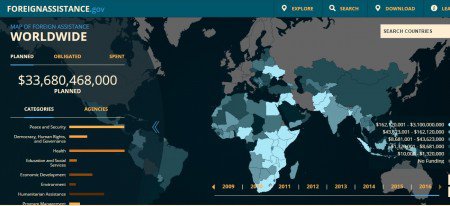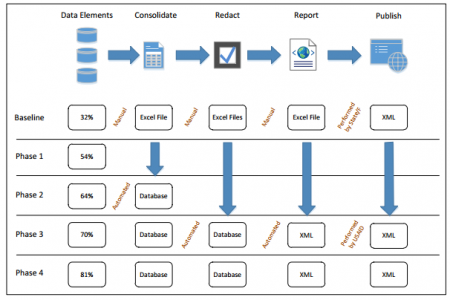USAID’s Strategic Approach to Improving IATI Compliance
In July, USAID showcased its continued and strengthened commitment to aid transparency, with the launch of the IATI Cost Management Plan (CMP). This document is a roadmap for USAID as it plays a leading role in the U.S. Government’s work to enhance aid transparency and foster more effective and accountable development.
IATI strongly supports USAID’s efforts to strategically build on its existing IATI data publication process. The CMP is a great asset, not only in guiding USAID, but also in providing a roadmap, and a set of commitments, to existing and future users of USAID data.
We asked Alex Thier, Assistant to the Administrator for the Bureau for Policy, Planning and Learning and Angelique Crumbly, Assistant Administrator for the Bureau for Management at USAID about the work their Agency has done to complete the CMP and their ideas for the future.
What sparked the idea to develop the IATI Cost Management Plan?
The Obama Administration places unparalleled emphasis on transparency and openness across the government. In support of this effort, USAID became the first U.S. Government agency to report transaction-level data to ForeignAssistance.gov in July 2013. While this represented a big step forward in providing detailed information about how and with whom USAID works, we remained mindful of the additional effort needed to fulfill our IATI commitments.
What do you hope will be the impact of the Cost Management Plan?
Quality information and timely reporting about development cooperation helps all stakeholders—governments, civil society organizations, private citizens, and donors alike—to manage and monitor aid resources more effectively. Increased transparency will improve efficiency and effectiveness, reduce reporting overlaps, strengthen evidence-based learning, and support anti-corruption measures. Additionally, after we implemented Phase One of the CMP, our Publish What You Fund Aid Transparency Index score, which compares donors’ data transparency levels, increased more than 20 points and moved USAID from “Fair” to “Good.” This was an exciting, tangible way to demonstrate our progress, and this success raised awareness around the Agency on these important efforts.
Do you have any advice for other publishers hoping to improve their compliance with the IATI Standard?
Creating a cost management plan was an involved process. In addition to requiring critical self-examination, making good on our commitments will require both resources and behaviour change, only achievable with Agency-wide support. However, having a realistic plan—complete with timelines—is a necessary tool for any organization. Take the time to thoroughly review your systems against each data element, and identify what is realistic for you. The process is not easy, but it is most definitely worth it.
What Does the CMP Entail?
The objectives of the CMP are many and include:
- Complying with and improving USAID’s reporting to the IATI standard and advancing aid transparency commitments;
- Streamlining and institutionalizing USAID’s quarterly reporting to IATI in order to improve data quality and efficiency;
- Fully complying, to the extent possible, with ForeignAssistance.gov reporting elaborated in the Office of Management and Budget Bulletin 12-01; and
- Increasing USAID’s ranking in Publish What You Fund’s annual Aid Transparency Index.
The CMP is also broken down into four phases, which reflect a gradual, step-by-step approach to compliance, and cover all aspects of the publication process: political, technical and systems-related.
- Phase One was implemented while the CMP was still in development. This phase improved USAID’s reporting on 15 IATI data elements, increasing USAID’s reporting to cover 54 percent of IATI data elements including providing links to organizational level files and reporting additional fields such as conditions, type of finance, and status of the activity.
- Phase Two will add or improve data on seven IATI elements including links to impact appraisals, evaluations, and in-language activity titles and descriptions. It will also streamline reporting by replacing the existing manual and labour-intensive spreadsheet-based system with an automated process for assembling IATI data. This is expected to create time savings for the extraction of data, and will increase USAID’s reporting to include 64 percent of IATI data elements.
- Phase Three will add or improve data on four IATI indicators that show sub-national geographic data, objectives, contact details, and activity websites, and improve the management of the redaction process that ensures protection of sensitive information. It will also result in USAID producing its own XML reporting files, and will increase USAID’s reporting to include 70 percent of IATI data elements.
- Phase Four, which was not approved but deferred, will add or improve reporting on eight IATI indicators that include results, latitude/longitude coordinates, tenders, and policy markers. These will result in USAID publishing 81 percent of IATI data elements – the maximum level of compliance possible to continue to adhere to privacy laws. In this phase, USAID will modify corporate systems and reporting processes to provide more comprehensive data. Phase Four is deferred, pending work on a new internal information solution.
For more information, you can reach out to USAID at [email protected]. If you are a development cooperation provider and would like to discuss ways you can improve your data, please contact the IATI Technical Team.

